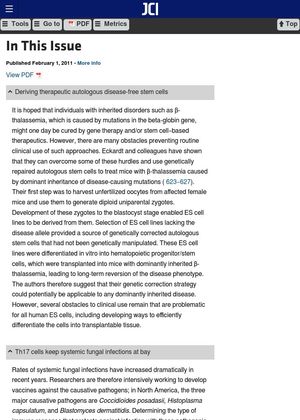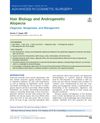In This Issue
February 2011
in “
Journal of Clinical Investigation
”

TLDR Genetically repaired stem cells may treat certain genetic diseases, Th17 cells are key in fighting systemic fungal infections, hair loss in AGA is due to progenitor cell loss, and α-synuclein transfer might contribute to Parkinson's disease progression.
In 2011, four significant studies were conducted. Eckardt and colleagues demonstrated the potential of using genetically repaired autologous stem cells to treat mice with β-thalassemia, a disease caused by mutations in the beta-globin gene. They suggested that their genetic correction strategy could potentially be applicable to any dominantly inherited disease, although there were still obstacles to clinical use. Wüthrich and colleagues found that Th17 cells, not Th1 cells, were necessary and sufficient to protect mice against three major fungi causing systemic fungal infections in North America. They suggested that vaccines should be designed to induce Th17 cells. Garza and colleagues investigated androgenetic alopecia (AGA), a common form of hair loss. They found that the loss of progenitor cells, not stem cells, contributes to the pathogenesis of AGA. Lastly, Hansen, Angot, and colleagues suggested that intercellularly transferred α-synuclein could play a role in the progression of neuropathology in Parkinson's disease, based on their studies in several coculture systems and in vivo models.






